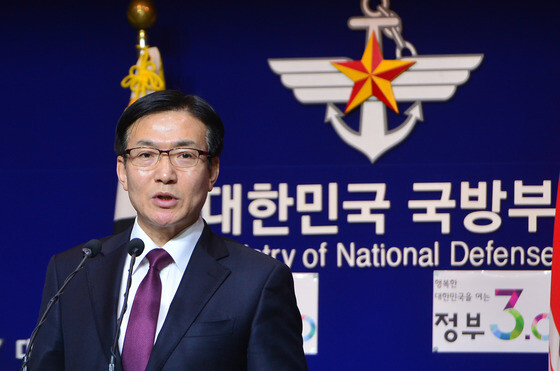hankyoreh
Links to other country sites 다른 나라 사이트 링크
S. Korea may provide Japan with radar information from THAAD system

The Ministry of National Defense announced on Aug. 4 that it may provide Japan with radar intelligence from a Terminal High Altitude Area Defense (THAAD) system to be deployed with US Forces Korea.
The news appears likely to feed speculation that the THAAD system would in fact be part of a US-led trilateral missile defense system with Japan.
The announcement by ministry spokesperson Moon Sang-kyun at a regular briefing on Aug. 4 came in response to a question on whether THAAD radar intelligence might be shared with Japan if requested.
“We’ve determined that to be possible within the scope of the South Korea-US-Japan information sharing agreement,” Moon replied.
“According to the agreement, intelligence related to North Korean nuclear weapons and missiles is to be shared [with Japan] by way of the US, and those procedures are currently being followed,” he added.
In Dec. 2014, South Korea, the US, and Japan signed an information sharing agreement that laid the institutional groundwork for real-time sharing of North Korean nuclear and missile intelligence. In June of this year, the three sides held their first-ever missile intelligence sharing exercises. Moon’s remarks on Aug. 4 suggest North Korean missile intelligence detected by THAAD radar on the Korean Peninsula could be passed along to Japan according to the trilateral agreement.
But the remarks also conflict with a response to the National Assembly by Minister of National Defense Han Min-koo, who said no intelligence from the USFK THAAD system would be shared with Japan. Han’s reply came in answer to questions at an emergency Q&A session at the Assembly’s regular session on July 19 over whether South Korea would be sharing THAAD radar intelligence with Japan.
“It will not,” he said at the time. “THAAD radar provides interception targets, so its function is for making a decision on where to intercept enemy missiles in its area. [The idea of] intelligence going to Japan is meaningless.”
Han’s remarks were intended to rebut claims that the THAAD deployment meant South Korea was being brought into the US-led missile defense system.
“THAAD is a system to defend South Korea within the Korean Peninsula,” he said at the time. “It is designed not to have intelligence sharing so that it is not involved in the US’s regional missile defense.”
For this reason, Moon’s remarks about the possibility of sharing THAAD radar intelligence with Japan are expected to reignite questions about whether THAAD is indeed meant to be part of the US missile defense system. Currently, the South Korean military and USFK are scheduled to link their missile defense by the end of 2016 to form a real-time intelligence sharing system. US Forces Japanese already shares intelligence in real time through a missile defense network with the Japan Self-Defense Forces - leading some to contend that the THAAD system on the Korean Peninsula is poised to serve as a key asset in a trilaterally linked missile defense network.
A Ministry of National Defense official tried to downplay the significance of Moon‘s explanation, saying it was “meant in theoretical terms.”
“THAAD is basically a US asset linked with USFK’s missile defense network,” the official said.
“If sharing of intelligence between South Korea, the US, and Japan is absolutely essential, we‘ll do it. Otherwise, we won’t,” the official added. “It’s a situational decision.”
The message is ultimately a very different one from “no intelligence sharing at all.”
By Park Byong-su, senior staff writer
Please direct questions or comments to [english@hani.co.kr]

Editorial・opinion
![[Column] Has Korea, too, crossed the Rubicon on China? [Column] Has Korea, too, crossed the Rubicon on China?](https://flexible.img.hani.co.kr/flexible/normal/500/300/imgdb/original/2024/0419/9317135153409185.jpg) [Column] Has Korea, too, crossed the Rubicon on China?
[Column] Has Korea, too, crossed the Rubicon on China?![[Correspondent’s column] In Japan’s alliance with US, echoes of its past alliances with UK [Correspondent’s column] In Japan’s alliance with US, echoes of its past alliances with UK](https://flexible.img.hani.co.kr/flexible/normal/500/300/imgdb/original/2024/0419/2317135166563519.jpg) [Correspondent’s column] In Japan’s alliance with US, echoes of its past alliances with UK
[Correspondent’s column] In Japan’s alliance with US, echoes of its past alliances with UK- [Editorial] Does Yoon think the Korean public is wrong?
- [Editorial] As it bolsters its alliance with US, Japan must be accountable for past
- [Guest essay] Amending the Constitution is Yoon’s key to leaving office in public’s good graces
- [Editorial] 10 years on, lessons of Sewol tragedy must never be forgotten
- [Column] A death blow to Korea’s prosecutor politics
- [Correspondent’s column] The US and the end of Japanese pacifism
- [Guest essay] How Korea turned its trainee doctors into monsters
- [Guest essay] As someone who helped forge Seoul-Moscow ties, their status today troubles me
Most viewed articles
- 1[Column] The clock is ticking for Korea’s first lady
- 2Samsung barricades office as unionized workers strike for better conditions
- 3[Correspondent’s column] In Japan’s alliance with US, echoes of its past alliances with UK
- 4After 2 months of delayed, denied medical care, Koreans worry worst may be yet to come
- 5[Column] Has Korea, too, crossed the Rubicon on China?
- 6Hong Se-hwa, voice for tolerance whose memoir of exile touched a chord, dies at 76
- 7US overtakes China as Korea’s top export market, prompting trade sanction jitters
- 8All eyes on Xiaomi after it pulls off EV that Apple couldn’t
- 9[Photo] Smile ambassador, you’re on camera
- 10[News analysis] After elections, prosecutorial reform will likely make legislative agenda